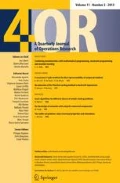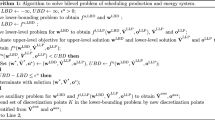Abstract
We provide decision-making models for a manufacturer which plans to produce multiple short life cycle products with the one-shot decision theory. The obtained optimal production quantities are based on the most appropriate scenarios for the manufacturer. Since the models are the bilevel programming problems with the max–min or min–max operator in the lower levels, we propose two approaches to translate them into general single-level optimization problems such that they can be solved via the commonly used optimization methods. The effectiveness of our approaches is examined from the theoretical and computational aspects.
Similar content being viewed by others
References
Alem DJ, Morabito R (2012) Production planning in furniture settings via robust optimization. Comput Oper Res 39(2):139–150
Allais M Le (1953) Comportement de l’homme rationnel devant le risque: critique des postulats et axiomes de l’ecole americaine. Econometrica 21(4):503–546
Allende GB, Still G (2013) Solving bilevel programs with the KKT-approach. Math Program 138(1–2):309–332
Alvarez PP, Vera JR (2014) Application of robust optimization to the sawmill planning problem. Ann Oper Res 219(1):457–475
Aouam T, Brahimi N (2013) Integrated production planning and order acceptance under uncertainty: a robust optimization approach. Eur J Oper Res 228(3):504–515
Ardjmand E, Weckman GR, Young WA II, Sanei Bajgiran O, Aminipour B (2016) A robust optimisation model for production planning and pricing under demand uncertainty. Int J Prod Res 54(13):3885–3905
Bagnoli M, Bergstrom T (2005) Log-concave probability and its applications. Econ Theory 26(2):445–469
Bard JF (1991) Some properties of the bilevel programming problem. J Optim Theory Appl 68(2):371–378
Ben-Tal A, Goryashko A, Guslitzer E, Nemirovski A (2004) Adjustable robust solutions of uncertain linear programs. Math Program 99(2):351–376
Ben-Tal A, El Ghaoui L, Nemirovski A (2009) Robust optimization. Princeton University Press, Princeton
Birge JR, Louveaux F (1997) Introduction to stochastic programming. Springer, New York
Bordalo P, Gennaioli N, Shleifer A (2012) Salience theory of choice under risk. Q J Econ 127(3):1243–1285
Bornapour M, Hooshmand RA (2015) An efficient scenario-based stochastic programming for optimal planning of combined heat, power, and hydrogen production of molten carbonate fuel cell power plants. Energy 83:734–748
Busse MR, Lacetera N, Pope DG, Silva-Risso J, Sydnor JR (2013) Estimating the effect of salience in wholesale and retail car markets. Am Econ Rev 103(3):575–579
Carvalho AN, Oliveira F, Scavarda LF (2016) Tactical capacity planning in a real-world ETO industry case: a robust optimization approach. Int J Prod Econ 180:158–171
Charnes A, Cooper WW (1959) Chance-constrained programming. Manag Sci 6(1):73–79
Chen X, Sim M, Sun P (2007) A robust optimization perspective on stochastic programming. Oper Res 55(6):1058–1071
Chen X, Sim M, Sun P, Zhang J (2008) A linear decision-based approximation approach to stochastic programming. Oper Res 56(2):344–357
Colson B, Marcotte P, Savard G (2005) Bilevel programming: a survey. 4OR 3(2):87–107
Dantzig GB (1955) Linear programming under uncertainty. Manag Sci 1(3–4):197–206
Dempe S (2002) Foundations of bilevel programming. Springer, Berlin
Dempe S, Zemkoho AB (2012) On the Karush–Kuhn–Tucker reformulation of the bilevel optimization problem. Nonlinear Anal Theory Methods Appl 75(3):1202–1218
Dempe S, Zemkoho AB (2013) The bilevel programming problem: reformulations, constraint qualifications and optimality conditions. Math Program 138(1–2):447–473
Ellsberg D (1961) Risk, ambiguity and savage axioms. Q J Econ 75(4):643–669
Fisher ML (1997) What is the right supply chain for your product? Harv Bus Rev 75:105–116
Gorissen BL, Den Hertog D (2013) Robust counterparts of inequalities containing sums of maxima of linear functions. Eur J Oper Res 227(1):30–43
Graves SC (2011) Uncertainty and production planning. In: Kempf KG, Keskinocak P, Uzsoy R (eds) Planning production and inventories in the extended enterprise, vol 1. Springer, US, pp 83–101
Guo P (2010) One-shot decision approach and its application to duopoly market. Int J Inf Decis Sci 2(3):213–232
Guo P (2011) One-shot decision theory. IEEE Trans Syst Man Cybern Part A Syst Hum 41(5):917–926
Guo P, Li Y (2014) Approaches to multistage one-shot decision making. Eur J Oper Res 236(2):612–623
Guo P, Ma X (2014) Newsvendor models for innovative products with one-shot decision theory. Eur J Oper Res 239(2):523–536
Guo P, Yan R, Wang J (2010) Duopoly market analysis within one-shot decision framework with asymmetric possibilistic information. Int J Comput Intell Syst 3(6):786–796
Guo L, Lin GH, Ye JJ (2015) Solving mathematical programs with equilibrium constraints. J Optim Theory Appl 166(1):234–256
Gyulai D, Pfeiffer A, Monostori L (2016) Robust production planning and control for multi-stage systems with flexible final assembly lines. Int J Prod Res 55(13):3657–3673
Hanasusanto GA, Roitch V, Kuhn D, Wiesemann W (2015) A distributionally robust perspective on uncertainty quantification and chance constrained programming. Math Program 151(1):35–62
Higle JL, Kempf KG (2011) Production planning under supply and demand uncertainty: a stochastic programming approach. In: Infanger G (ed) Stochastic programming. Springer, New York, pp 297–315
Ho CJ (1989) Evaluating the impact of operating environments on MRP system nervousness. Int J Prod Res 27(7):1115–1135
Hoheisel T, Kanzow C, Schwartz A (2013) Theoretical and numerical comparison of relaxation methods for mathematical programs with complementarity constraints. Math Program 137(1–2):257–288
Kahneman D, Tversky A (1979) Prospect theory: an analysis of decision under risk. Econometrica 47(2):263–292
Kazemi Zanjani M, Nourelfath M, Ait-Kadi D (2010) A multi-stage stochastic programming approach for production planning with uncertainty in the quality of raw materials and demand. Int J Prod Res 48(16):4701–4723
Koca E, Yaman H, Akturk MS (2015) Stochastic lot-sizing with controllable processing times. Omega 53:1–10
Lin GH, Xu M, Ye JJ (2014) On solving simple bilevel programs with a nonconvex lower level program. Math Program 144(1–2):277–305
Luo ZQ, Pang JS, Ralph D (1996) Mathematical programs with equilibrium constraints. Cambridge University Press, Cambridge
Miller BL, Wagner HM (1965) Chance constrained programming with joint constraints. Oper Res 13(6):930–945
Mula J, Poler R, Garcia-Sabater JP, Lario FC (2006) Models for production planning under uncertainty: a review. Int J Prod Econ 103(1):271–285
Nasiri GR, Zolfaghari R, Davoudpour H (2014) An integrated supply chain production distribution planning with stochastic demands. Comput Ind Eng 77:35–45
Nemirovski A, Shapiro A (2006) Convex approximations of chance constrained programs. SIAM J Optim 17(4):969–996
Orquin JL, Loose SM (2013) Attention and choice: a review on eye movements in decision making. Acta Psychol 144(1):190–206
Outrata JV (1990) On the numerical solution of a class of Stackelberg problems. Math Methods Oper Res 34(4):255–277
Pagnoncelli BK, Ahmed S, Shapiro A (2009) Sample average approximation method for chance constrained programming: theory and applications. J Optim Theory Appl 142(2):399–416
Savage LJ (1954) The foundations of statistics. Wiley, New York
Scheel H, Scholtes S (2000) Mathematical programs with complementarity constraints: stationarity, optimality, and sensitivity. Math Oper Res 25(1):1–22
Sen A (2008) The US fashion industry: a supply chain review. Int J Prod Econ 114(2):571–593
Shapiro A, Dentcheva D, Ruszczyński A (2009) Lectures on stochastic programming: modeling and theory. Society for Industrial and Applied Mathematics, Philadelphia
Shi J, Zhang G, Sha J (2011) Optimal production planning for a multi-product closed loop system with uncertain demand and return. Comput Oper Res 38(3):641–650
Sodhi MS, Tang CS (2009) Modeling supply-chain planning under demand uncertainty using stochastic programming: a survey motivated by asset-liability management. Int J Prod Econ 121(2):728–738
Starmer C (2000) Developments in non-expected utility theory: the hunt for a descriptive theory of choice under risk. J Econ Lit 38(2):332–382
Stephen B, Vandenberghe L (2004) Convex optimization. Cambridge University Press, Cambridge
Stewart N, Hermens F, Matthews WJ (2016) Eye movements in risky choice. J Behav Decis Mak 29(2–3):116–136
Tang L, Che P, Liu J (2012) A stochastic production planning problem with nonlinear cost. Comput Oper Res 39(9):1977–1987
Thomassey S (2010) Sales forecasts in clothing industry: the key success factor of the supply chain management. Int J Prod Econ 128(2):470–483
von Neumann J, Morgenstern O (1944) Theory of games and economic behavior. Princeton University Press, Princeton
Wang C, Guo P (2017) Behavioral models for first-price sealed-bid auctions with the one-shot decision theory. Eur J Oper Res 261(3):994–1000
Wazed M, Ahmed S, Nukman Y (2010) A review of manufacture resources planning models under different uncertainties: state-of the-art and future directions. S Afr J Ind Eng 21(1):17–33
Wiesemann W, Kuhn D, Sim M (2014) Distributionally robust convex optimization. Oper Res 62(6):1358–1376
Yanikoǧlu I, Kuhn D (2018) Decision rule bounds for two-stage stochastic bilevel programs. SIAM J Optim 28(1):198–222
Ye JJ, Zhu DL (1995) Optimality conditions for bilevel programming problems. Optimization 33(1):9–27
Zhu X, Guo P (2016) The one-shot decision theory based production planning models. In: Proceedings of IEEE international conference on industrial engineering and engineering management, December 4–7. pp 789-792
Zhu X, Guo P (2017) Approaches to four types of bilevel programming problems with nonconvex nonsmooth lower level programs and their applications to newsvendor problems. Math Methods Oper Res 86(2):255–275
Zymler S, Kuhn D, Rustem B (2013) Distributionally robust joint chance constraints with second-order moment information. Math Program 137(1–2):167–198
Acknowledgements
This research was supported by JSPS KAKENHI Grant Number 15K03599.
Author information
Authors and Affiliations
Corresponding author
Ethics declarations
Conflict of interest
We declare that no conflict of interest exists in this paper.
Additional information
Publisher's Note
Springer Nature remains neutral with regard to jurisdictional claims in published maps and institutional affiliations.
Rights and permissions
About this article
Cite this article
Zhu, X., Guo, P. Bilevel programming approaches to production planning for multiple products with short life cycles. 4OR-Q J Oper Res 18, 151–175 (2020). https://doi.org/10.1007/s10288-019-00407-z
Received:
Revised:
Published:
Issue Date:
DOI: https://doi.org/10.1007/s10288-019-00407-z




